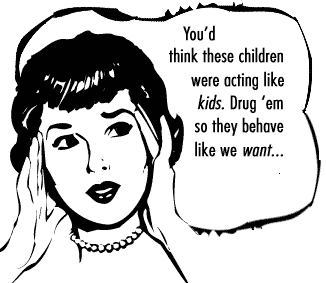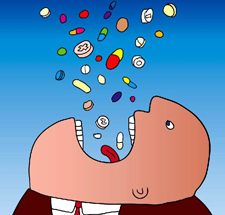Direct-to-Consumer-Advertising and the Archipelago of Medicalization Black Hawk Hancock / DePaul University

In my previous article, I mapped out some of the ways that medical direct-to-consumer-advertising worked to induce us into thinking about ourselves, not just as patients, but as consumers and objects of medical treatment. In this way, direct-to-consumer-advertising (DTCA) served to medicalize social life—the process through which a human condition or state becomes defined a problem in medical terms and requires medical intervention to treat. Here my aim is to draw out DCTA within the larger context of medical advertising and the concerns that bigger picture raises for us.
While Big Pharmaceutical is always the first target of attack, and they certainly should be held responsible for playing their part in medicalization, they are but one of many who contribute to the current state of affairs. Therefore, what is needed is a way to conceptualize the diversity of advertisers, the vast number of advertisements, and the ways those ads circulate throughout social life. In order to do so, I draw on Michel Foucault’s metaphor of the “carceral archipelago,” one which he used to describe how relations of power were both physically dispersed yet encompassed all of society, as a way to conceptualize the state of contemporary medical media. 1 Extending this metaphor to the way that individuals are always embedded in a plurality of social relations, of which mass media are fundamentally constitutive, serves to highlight the field of socializing forces that medical advertising plays in everyday life. Drawing on the archipelago as a cluster of related islands, advertisements form a network of interconnected signs, symbols and points of socialization—each contributes to the whole and the whole is reflected in each specific instance as a conduit for medicalization.

Just as individuals are socialized through institutions and other individuals, they are also socialized through forms of media such as DTCA. While traditional forms of television and print advertisements continue to be an advertising staple, advertising has moved to every visible surface from cars, to billboards, to packaging, in an ongoing attempt to catch the eye of the consumer at every turn. As reported in the New York Times, Yankelovich, a market research firm, “estimates that a person living in a city 30 years ago saw up to 2,000 ad messages a day, compared with up to 5,000 today. About half the 4,110 people surveyed last spring by Yankelovich said they thought marketing and advertising today was out of control.” 2 While DTCA is but one segment of this saturation of the social landscape, it has become the primary way individuals receive medical information. 3 By conceptualizing the crisscrossing field of advertisements as constitutive of the carceral archipelago, medical advertising in its multiple manifestations (print, mass media, internet, and other forms), and sheer numbers in occupying space and time, forms a systematic totality, interconnecting and reinforcing the medicalization of social life.

DTCA is not detached from, rather it is embedded in, the social relations that make up everyday life. As Shannon Brownlee argues in her book, Overtreated: Why Too Much Medicine is Making Us Sicker and Poorer, DTCA has become “so ubiquitous you cannot walk past more than a few feet of airport hallway, watch network television for more than a few minutes or turn more than a few pages of a magazine without seeing an ad.” As a result, she concludes that advertising is becoming increasingly specialized and sophisticated in discovering ways to get “consumers to think of drugs as the solution to a wider and wider array of ailments.”4 Complementing Brownlee’s findings, a recent study published in the Annals of Family Medicine under the title “Creating Demand for Prescription Drugs” documented that Nielsen now estimates that on any given day, on average 80 DTCA air per hour. 5 In addition, in 2009, medicines were the second most frequently advertised consumer product on TV, outflanked only by automobiles. Moreover, based on averages, Americans see more than 16 hours of DTCA per year, which slightly outweighs the 15 minutes per year of time they spend with a doctor. 6 While DTCA serves as the primary focus here, it is necessary to consider how these advertisements themselves fit into an even greater array of advertisements—for hospitals, health-care organizations, care centers, clinics, physical therapy institute and outpatient clinics, doctors, freestanding diagnostic centers, and academic medical centers—that all advertise medications and services that can solve problems. Even disease-awareness campaigns have become a special form of advertising, where once they were public service announcements, now they involve paid advertising, where “instead of promoting healthy lifestyles, the campaigns are pushing the early detection of disease, encouraging you to get checked for any one of a number of health concerns.” 7 In addition, marketing of pharmaceuticals now involves help from the press as a “third-party strategy.” Here, the message is channeled through a seemingly independent source, one other than the pharmaceutical company, in order to make the story appear to be more credible.
This medicalized mass-mediated world has led to a general disposition towards medicine and social life by which people go to their physicians for symptoms that previously had not been recognized or considered treatable, leading to “medical care by advertisement instead of medical care by doctors and nurses.” 8 Furthermore, this nexus of advertisements has induced an “enthusiasm for diagnosis” where Americans have been “trained to be concerned about our health” since possible conditions or abnormalities may exist which should be discovered and treated. This has led some to consider this interconnected state of affairs all part of “an epidemic of diagnosis” in which the apparent constant screening for something to be wrong has in turn created an unforeseen danger, that of “overdiagnosis,” whereby we are in constant pursuit of detecting abnormalities that have no medical consequences at all.
Returning to the archipelago, the contemporary condition leaves us without a map or a sextant. Despite efforts to become better informed as patients and consumers, so long as we remain trapped in the archipelago of advertising, we will remain adrift in uncharted waters. Without bearings or direction to navigate an unending array of medical advertisements, those who engage in media critique (myself included), may want to prioritize our intellectual efforts on forging alliances with those who can assist in promoting health literacy, both within and beyond the realm of advertising, before we all become truly lost at sea.
Image Credits:
1. Consent of the Governed
2. Cheap Cars Domain
3. High School Bioethics
Please feel free to comment.
- Foucault, Michel. 1975. Discipline and Punish. New York: Vintage Books. [↩]
- Story, Louise. 2007. “Anywhere the Eye Can See, It’s Likely to See an Ad.” New York Times: January 15. [↩]
- Frosch, D., May,G., Tietbohl, C., and Pagan, J. 2011. “ Living in the “land of no”? Consumer perceptions of healthy lifestyle portrayals in direct-to-consumer advertisements of prescription drugs.” Social Science & Medicine. 73(7): 995-1002. [↩]
- Brownlee, S. 2007. Overtrated: Why Too Much Medicine is Making Us Sicker and Poorer. New York: Bloomsbury. [↩]
- Frosch, D., Krueger, P., Hornik, R., Cronholm, P., and Barg, F. 2007. “Creating Demand for Prescription Drugs: A Content Analysis of Television Direct-to-Consumer Advertising.” Annals of Family Medicine 5(1): 6-13. [↩]
- Brownfield ED, Berhardt JM, Phan JL, Williams MW, Parker RM. 2004. Direct-to-consumer drug advertisements on network television: an exploration of quantity, frequency, and placement. J. Health Commun. 9:491–97 [↩]
- Welch, G., Schwartz, L. and Woloshin, S. (2011) Overdiagnosed: Making People Sick in the Pursuit of Health. New York: Beacon Press. [↩]
- Angell, Marcia. (2004) The Truth about Drug Companies. New York: Random House. [↩]